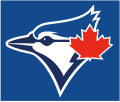| Toronto Blue Jays | |||||
|---|---|---|---|---|---|
| |||||
| |||||
| Major league affiliations | |||||
| |||||
| Current uniform | |||||
 | |||||
| Retired numbers | |||||
| Colours | |||||
| Name | |||||
| |||||
| Other nicknames | |||||
| |||||
| Ballpark | |||||
| |||||
| Major league titles | |||||
| World Series titles (2) | |||||
| AL Pennants (3) | |||||
| AL East Division titles (7) | |||||
| Wild card berths (4) | |||||
| Front office | |||||
| Principal owner | Rogers Communications [4] | ||||
| President | Mark Shapiro | ||||
| General manager | Ross Atkins | ||||
| Manager | John Schneider | ||||
| Website | mlb.com/bluejays | ||||
The Toronto Blue Jays are a Canadian professional baseball team based in Toronto. The Blue Jays compete in Major League Baseball (MLB) as a member club of the American League (AL) East Division. Since 1989, the team has played its home games primarily at Rogers Centre in the South Core of downtown Toronto.
Contents
- History
- 2024 season
- 2025 season
- 2026 season
- Popularity
- Culture
- "OK Blue Jays"
- "Let's Go Blue Jays"
- Mascots
- Sunday Salute
- National anthems
- Canada Day
- Fan Appreciation Weekend
- Jays Shop
- Uniforms
- 1977–1988: Pullovers and powder blue
- 1989–1996: Championship blues
- 1997–2003: Red, teal and blue
- 2004–2011: The "Black-and-Graphite Jays"
- 2012–present: Return to traditional look
- Canada Day uniforms
- City Connect uniform
- Rivalries
- Detroit Tigers
- Seattle Mariners
- Montreal Expos
- Broadcasting
- Radio
- Television
- Roster
- Minor league affiliations
- Season by season record
- Awards and other achievements
- Award winners and league leaders
- Franchise records
- No-hitters
- Triple Crown champions
- Baseball Hall of Famers
- Ford C. Frick Award recipients
- BBWAA Career Excellence Award recipients
- Canadian Baseball Hall of Fame
- Retired numbers
- Level of Excellence
- Charity and partnerships
- Notes
- References
- External links
The name "Blue Jays" originates from the blue jay bird, and blue is also the traditional colour of Toronto's collegiate and professional sports teams including the Maple Leafs (ice hockey) and the Argonauts (Canadian football). In 1976, out of the over 4,000 suggestions, 154 people selected the name "Blue Jays." [5] In addition, the team was originally owned by the Labatt Brewing Company, makers of the popular beer Labatt Blue. Colloquially nicknamed the "Jays," the team's official colours are royal blue, navy blue, red, and white. [1] [2]
An expansion franchise, the club was founded in Toronto in 1977. Originally based at Exhibition Stadium, the team began playing its home games at SkyDome upon its opening in 1989. They are the second MLB franchise to be based outside the United States, and the only one remaining since the first Canadian franchise, the Montreal Expos, became the Washington Nationals in 2005. Since 2000, the Blue Jays have been owned by Rogers Communications and in 2004, SkyDome was purchased by that company, which renamed it Rogers Centre. The Blue Jays and the Atlanta Braves [d] are the only two MLB teams under corporate ownership; the Blue Jays are the only American League team to be under such ownership.
Due to border restrictions brought about by the COVID-19 pandemic, the Blue Jays played home games at TD Ballpark in Dunedin, Florida, for April and May of the 2021 season, and Sahlen Field in Buffalo, New York, for the 2020 season as well as June and July 2021, returning home to Toronto on July 30 of that year.
In the late 1970s and early 1980s, the Blue Jays went through struggles typical of an expansion team, frequently finishing last in their division. In 1983, they had their first winning season and two years later, became division champions. From 1985 to 1993, the Blue Jays were an AL East powerhouse, winning five division championships in nine seasons, including three consecutive from 1991 to 1993. During that run, the team also became back-to-back World Series champions in 1992 and 1993, led by a core group of award-winning All-Star players, including Hall of Famer Roberto Alomar, Joe Carter, John Olerud, and Devon White. The Blue Jays became the first (and, to date, only) team outside the U.S. to appear in and win a World Series and the fastest AL expansion team to do so, winning in their 16th year. After 1993, the Blue Jays failed to qualify for the playoffs for 21 consecutive seasons until clinching a playoff berth and division championship in 2015. The team clinched a second consecutive playoff berth in 2016, after securing an AL wild card position. In both years, the Blue Jays beat the Texas Rangers in the AL Division Series, but lost the AL Championship Series. Most recently, they qualified for the playoffs as a wild card team in 2020, 2022, and 2023. In 2025, the Blue Jays won their seventh division title and their third American League pennant, but lost in the World Series to the Los Angeles Dodgers.
From 1977 to 2025, the Blue Jays' overall win-loss record is 3,855–3,856–3 (.500). [6]








